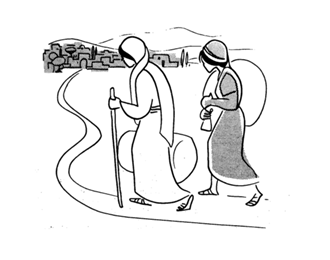Ruth 1
13-08-2020 - Posted by Andre PietRuth in the Hebrew Bible
In our Bible, the book of Ruth is placed directly after the book of Judges. This is because the history described in this booklet took place during Judges time (1: 1). In the original Hebrew Bible, however, it is part of “the Scriptures”. More especially of the festivityscrolls, the so-called Megillot. “Ruth” is read at the Feast of Weeks, or the Pentecost. Of course because this romance culminates at the wheat harvest (2:23) … so around the time of Pentecost.
Pentecost in the end time
Yet there is much more behind this. This booklet has great prophetic dimensions! “Ruth” speaks of Pentecost in the end time. When in the last days “the Spirit of grace and of supplications” will be poured out upon the inhabitants of Jerusalem (Acts 2:17; Zech. 12:10).
the root of David
The last word in ‘Ruth’ is David. In fact, that is also the point of the book. It is namely the story of how the Kingdom over Israel came about. It is about the city of David that is not primarily Jerusalem, but Bethlehem. Bethlehem means ‘house of bread’. It is in the fields of Ephratha, which means ‘fertility’. Of course it speaks of Him who fell into the earth like grain of wheat and died to produce fruit (John 12:24) and to be the bread “for the sake of the life of the world” (John 6:51).
Bethlehem
The first time Bethlehem is mentioned in the Scriptures is in Genesis 35:19. It describes how Rachel died giving birth to Jacob’s youngest son Benjamin. Rachel says the boy would be called Ben-Oni (son of my sorrow), but the father calls him Ben-jamin (son of the right hand). This refers to Him who, through death and sorrow, was destined to be the Son at God’s right hand. On this occasion a stone is erected in the fields of Efratha (Rachel’s grave). By definition, an erected stone refers to resurrection and resurrection and thus to life stronger than death.
the prophetic line in chapter 1
The people of Israel suffered badly from a famine. Ruth describes the adventures of a Jewish family who for that reason seek shelter abroad. But there, too, they are badly hit by the hand of the Lord, so that ultimately only a bitter Naomi returns to the land. Together with a pagan woman who has joined her people: Ruth (= ‘companion’). All of this is a prophetic reference to our days when we are witnessing the return of the Jewish people (including ‘fellows of the Jews’ such as Ruth). From the diaspora to the land of the fathers. After 2000 years of trouble and sorrow. But still without Man and Kinsman …
the beginning of the barley harvest
The tragedy of the first chapter ends with a hopeful announcement: upon arrival in the land (through the Jordan!) It is precisely “the beginning of the barley harvest” (1:22). In principle, bread is available …But there’s more!
The official beginning of the barley harvest is the day of the sheaf, “the day after the Sabbath” (Lev. 23: 10-16). And this very day, many centuries later, another wealthy man from Bethlehem rose from the dead. As the Firstfruits of mankind, He has left the grave empty forever behind Him (1 Cor.15: 20,22). So the beginning of the barley harvest refers to Easter!

 English Blog
English Blog